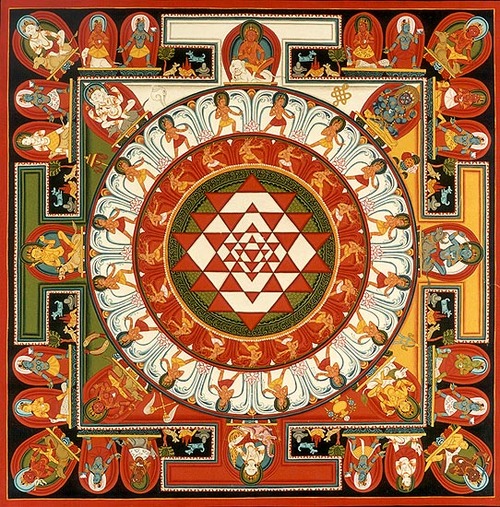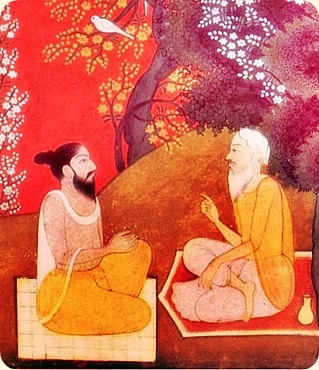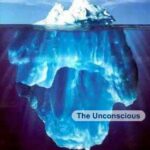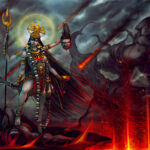The Philosophy of the East: The Legacy of the Indo-Aryans
Introduction
Throughout academic parlance in the Enlightenment Era intellectual and philosophical development throughout mankind’s history has been divided into Eastern and Western branches. The Eastern branch of thought and development for many centuries was looked upon as “Oriental”, a term that has fallen out of favor in academic and intellectual circles in no small measure due to the fact that it implied and originated within the context of the colonization of a good part of the “Eastern” world and Western academic pursuits into understanding the nature of theological and philosophical, as well as socio-political development of the so-called East – an outsiders view that came with its own bias that is considered by most scholars to be one of supremacy and dominance that looked down upon the cultural and religious systems of the East with not disdain per se but most certainly with a sense of arrogance and superiority.
The problem however, despite these known biases, is that the classification of East versus West does have a certain clarity and clean delineation in modes of thought however, modes of thought that are divided at least intellectually by what could be termed reductionist versus holistic. In other words, even if the classification of certain ways of thinking and development as a whole doesn’t have a specific geographical divide between East and West (although one could argue that in fact does), the tendency to break things down into parts and explore their relationships as individual automata and their interactions does in fact characterize Western thinking more or less since Hellenistic antiquity and the tendency to look at individuals within the context of their relationship to the whole, or the universe at large, does in fact characterize “Eastern” modes of thought to a great extent.
Charlie had spent a great deal of time considering and outlining as best he could the theological and philosophical development in the West, starting with ancient cosmological and theistic systems based upon the worship of deities, sacrificial practices and such that were steeped in mythology and then evolved into the monotheistic forms of religion which we are most familiar with and dominate the Western intellectual and theological landscape today – Judaism, Christianity and Islam – and out of which, mostly in reaction to, arose our fascination toward science proper which although has allowed for great advancements in science and technology has to a large extent left us with a very objective and reductionist view of reality.
There were parallel developments to the East however, to the East of ancient Greece, Rome and the Byzantine Empire which evolved very much independently to Western theological and philosophical development. Specifically we’re referring to the Vedic and Indo-Aryan tradition which arose out of ancient India based upon the philosophy of the Upanishads, the mythology of the Bhagavad Gita, Brahma Sutras and other ancient Indian texts and their subsequent interpretation from 2500 BCE onwards, the tradition of Buddhism which stemmed from the teachings of the great and influential Siddhartha Gautama who himself was greatly influenced by ancient Vedic religious doctrines and practices even if he rejected them for the most part, and in Taoism which took root in China and the far east from the middle of the first millennia onwards and still thrives today. These theological and philosophical systems of belief are interesting to analyze not just in the wisdom which they present but also as contrasting and opposing modes of thought to the reductionist and rationalist way of thinking which underpins modern science as well as the overall worldview of the West.
Arguably one of the unique contributions of Indo-Aryan philosophy (to which Vedanta and Buddhism ultimately owe their heritage) to modern day theology and spirituality is their fundamental belief in the individual nature of the religious experience and the faith in what is variously referred to as “realization”, “liberation”, “enlightenment”, or “nirvana” all of which are various terms used to describe the state or act of direct experience of the divine in this very life – juxtaposed with the focus on an afterlife in heaven which characterizes most if not all of the Western theological traditions. This fundamental belief lies at the heart of the Vedic philosophical system, which is the philosophical and mystical counterpart of Hinduism proper, as well the theo-philosophical system of Buddhism. [Taoism has a slightly different bent in that it focuses on the way and the balancing of opposites as the path to peace, tranquility and happiness rather than as enlightenment itself being the ultimate goal of life, more akin to Buddhism with its emphasis on the way than Vedanta per se].
What is Vedanta?
The ancient Indo-Aryan civilization sprung forth in the Indus valley region in modern day India and Pakistan (to the ancients Eastern Persia), and was the source of the “Vedas”, some of the oldest extant literature of mankind. This ancient Indus Valley civilization, from which one of the great world renowned religions called Hinduism was birthed, spread and flourished in the northwestern part of the Indian subcontinent from circa 3300 to 1300 BCE, roughly aligning with the peak of ancient Egyptian civilization although contact between the two civilizations was limited if not absent entirely based upon the archeological record. The civilization from which Hinduism emerged is traditionally associated with the Indus valley, a river system from which an ancient culture could grow crops and thrive, a similar relationship to the Sumerians and their Tigris/Euphrates and the Egyptians and their Nile. This relationship with water and its fundamental existence and prerequisite feature for the source of life, clearly left its mark on the Cosmology and creation mythology of all of these ancient cultures. The Hindus believed in the Cosmic Waters (apas in Sanskrit) as the source of the known universe, just as the Egyptians had their concept of Nu and the Ancient Sumerians had their Apsu.[2]
Their theological doctrines and philosophy, as reflected in the Vedas, was a core part of their society and from a very early stage and the social structure even was architected to reflect this, namely that the sacred teachings of the Vedas were to be protected by a specific class of society, the Brahmins. In some respects the establishment of a priestly, learned class that was kept separate from the rest of the society (the Kshatriya or ruling/warrior class, the Vaishyas or the merchant class and the Shudras or laborers being the other classes of society in classic Hindu culture) reflected developments to the West where first the priests, then the philosophers and then finally the Church itself (the Imam in the Muslim community) became the established authority on matters dealing with intellectual development, education, or course religious matters and ultimately eternal freedom.
Although in antiquity Vedānta referred more specifically to the philosophic portion of the Vedas (Vedanta literally means “end of the Vedas”), the bulk of the content coming from the Upanishads, over time Vedanta took on a broader meaning to represent the body of work and knowledge that interpreted the meaning of the Upanishads, which in turn incorporated the Bhagavad Gita and Brahma Sutras more directly into the philosophic tradition.
The primary sources for what is considered modern day Vedanta are three main collections of verses or texts are the Upanishads[3], representing the end of the Vedas or the philosophical and mystical portions of the Vedas, the Bhagavad Gita or “Song of the Lord” from the epic poem the Mahabharata, and the Brahma Sutras which was an attempt at consolidating and synthesizing Vedantic philosophy from the 2nd or third century CE. Vyasa is the supposed author attributed to the works of the Mahabharata and the Brahma Sutras, while the Upanishads are considered to be the divine inspiration of the rishis, or seers, who fully realized and codified the knowledge of Brahman as put forth in the Upanishads. The three works together are also referred to as the Prasthanas, or canonical books, that form the foundation of the philosophy of Vedanta and form the foundation of Hindu religion even to this day.
The Vedas are the oldest Indo-Aryan Sanskrit[4] texts and are the oldest extant Hindu scripture. The Sanskrit word véda means “knowledge” or “wisdom” and is derived from the root vid, “to know”. Like many other religious traditions, the Vedas are said not to have been recorded and authored per se, but were revealed to these ancient rishis, passed down from generation o generation from teacher to student in a long standing oral tradition, and then documented and transcribed by scholars and sages somewhere between the second and first millennium BCE. Vedanta, somewhat literally translated as “the end”, or “goal”, of the Vedas, represents the philosophical or metaphysical tradition of the Hindus and represents the philosophical portions of the Vedas, i.e. the portions of the Vedas that do not deal with sacrifice, ritual or dharma (righteous action).
Vedānta is also sometimes referred to as Uttarā-Mīmāṃsā, or the ‘latter’ or ‘higher’ inquiry, as juxtaposed with Purva-Mīmāṃsā, or the ‘former’ inquiry which deals with ritual and sacrifice described in the Samhita portion of the Vedas and Brahmanas while Vedanta proper expounds upon the more esoteric teachings of the Āranyakas and the Upanishads. As defined by Shankara, perhaps the greatest of all the Vedic philosophers in antiquity, the term Upanishad is in effect a veiled reference to the content of the Upanishad itself, namely Brahmavidya, knowledge of Brahman, and Atmavidya, knowledge of Self.
The corpus of Vedic texts, all transcribed in some form of Sanskrit, include the Samhita, which are collections of mantras from the four Vedas, the Brahmanas which are prose texts that describe Hindu sacrifice and ritual, some of the older Upanishads such as the Mukya, Chandogya, Katha and Brhadaranyaka which deal with esoteric ideas and concepts describing the nature of Brahman and the soul (Atman), and other sutra (literally “thread”) literature dealing with Hindu rituals and sacred rites. Each of the Brahmanas is associated with one of the Samhitas and may also include Aranyakas, literally “forest texts”, as well as Upanishad texts which again represent the philosophical and metaphysical, or perhaps better put mystical, interpretations of the sacred rituals.
Parts of the Brahmanas, Aranyakas, as well as Upanishads explore what have become the theological underpinnings of Hinduism, notions such as Brahman, the absolute or underlying nature of all things, and Atman, the individuation of the principle of Brahman in man or the soul as it is usually translated, the relationship of which represents the core pillars of Vedic philosophy. The Upanishads however form the philosophical backbone of Vedanta and much like the ancient scripture of the Jews (Old Testament) or Zoroastrians (Avesta), the Upanishads and the rest of the Vedic scripture in toto represent an oral tradition that reaches deep into antiquity that was only later documented, dated by most scholars in the second and first millennium BCE.
The oldest parts of Vedic literature, the Rig Veda for example, give us a glimpse of the life of the Indo-Aryan peoples who first settled and formed complex social structures in the Indus Valley some seven thousand years or so ago and the nature of the language of old Vedic Sanskrit points to shared linguistic and philological with Indo-Iranian culture and civilization that populated the region to the West dominated by the Tigris and Euphrates rivers.
The Rig Veda is one of, if not the, primary source texts of mythology, rituals and belief systems of the people of the Indus Valley region, and is one of the oldest extant texts in the Indo-European language family. It is thought to have been composed somewhere in the middle or end of the second millennium BCE (based upon philological and corroborated archeological evidence), roughly between 1700 and 1100 BCE. Even though the text is interspersed with mythology and outlines the characters and principles from which the known universe was birthed, the text also states unequivocally the unknowable nature of the source of the universe/cosmos, marking its core philosophical bent and providing the foundation for the later Upanishads which were primarily concerned with the nature of Brahman and Atman and their realization and manifestation rather than mythology per se.
Fundamental to the Upanishad texts themselves and the broader Vedanta philosophic tradition as a whole is the establishment of the importance of self-realization as the goal of life. In the Upanishads it is Brahman that represents the universal spirit that underlies all of the cosmos and all of its creation and it is through connection with Atman is that the individual can recognize their unity with all pervading Brahman. This knowledge is called “Brahmavidya”, or literally knowledge of Brahman, which reveals to the jiva the illusory nature of physical reality or maya, the universe being the “play”, lila of Ishvara. Brahman as espoused in the Upanishads, despite the tendency toward anthropomorphization, represents the ultimate unity of all things and creatures, animate and inanimate, and the belief in an indelible construct or consciousness which pervades the entire universe and which feeds and gives energy to all life.
Interpretations of Vedanta
The first attempt at compiling and synthesizing the teachings of Vedanta, their interpretation as it were, is contained in the Brahma Sutras (sometimes referred to as the Vedānta Sutras) which are believed to have been written somewhere around the 2nd century CE, the text being attributed to the mythical sage Vyasa who is also the author to whom the Mahabharata is attributed. The Brahma Sutras are part of the Uttara-Mimamsa (Vedantic) tradition and are in essence a summary and compilation of the teachings of the Upanishads. It is in the Brahma Sūtras that the teachings of Vedānta are set forth in a systematic and logical order, rather than the scattered and somewhat inconsistent manner which the teachings are presented in the Vedas given their deep historical and sometimes esoteric roots and their focus on ritual and sacrifice.
The Bhagavad Gita, or the “Song of the Lord”, has also played a significant role in the development of Vedantic thought over the centuries. The text is a part of the ancient Sanskrit epic the Mahabharata of which some of its oldest parts date from the middle or early part of the first millennium BCE. The Bhagavad Gita is a portion of this mythological epic text and is a narrative of a dialogue between Lord Krishna and Prince Arjuna that takes place on the eve of a great battle. Arjuna, whose name means “bright” or “shining”, is one of the five Pandava brothers, all sons of Pandu who are aligned against their cousins the Kauravas, descendents of Kuru in the Kurukshetra War. This is he stage from which Krishna, Arjuna’s charioteer, gives his great teaching around the nature of duty, the soul, the universe and the path to liberation – the “Song of the Lord” which is undoubtedly one of the greatest epics of all time commensurate in stature and influence to the East as the Iliad or the Odyssey is in the West.
Arjuna voices to Lord Krishna great reservations and misgivings about the righteousness of the war in general and more specifically the duty to kill his enemies, who in this particular case were his cousins. Krishna at one point in the dialogue reveals himself as God in a great vision to Arjuna and represented an example of the avatar tradition which is a marked and unique trait of the Hindu faith. An avatar is a human incarnation of the divine, one who although is none other than the great Ishvara himself takes human form from time to time to show jivas the true nature of existence and lay out the path to liberation for each new age.
Krishna helps Arjuna understand why he must fight, and why it is morally right for him to do so, and the context of this dialogue forms the essence of the philosophy of the Bhagavad Gita. In the process of his expositions, Lord Krishna expounds upon key Vedantic philosophical constructs such as moksha (liberation), karma (action), and dharma (righteous conduct), forming the foundation of the practice of Yoga and helping the great prince understand that while it may seem immoral for him to go to war with his kin, it is nonetheless his duty to do so and it would in fact be immoral to abstain from fighting. The metaphor is intended of course to not only justify the class differentiation which represented the fabric of ancient Hindu society but to hold Arjuna up to its people as a “shining” example of the just and moral life.
Outside of the esoteric notions of Brahman and Atman which are explored and eulogized in the more esoteric parts of Vedic scripture, there does also exist in the tradition a parallel notion of anthropomorphic deities consistent with the pantheon of gods that colored the mythology of the rest of the cultures from antiquity – The Greeks, Persians, Romans, Egyptians, etc. This concept of God, or Ishvara, is present in the Upanishads and the Vedas as well (and is topic of the Puranas, one of the other canonical works of Hinduism proper), but at least within Vedanta is subservient to the higher, more abstract, truths elucidated throughout the Vedic literature – Brahman alone is real, and it is through knowledge and realization of Atman and its ultimate unity with Brahman that the cycle of birth and death can be broken and the bondage of desire and attachment be rent asunder.
The core premise of the Upanishads and Vedanta in general then, and what distinguishes the philosophical system from the Western philosophical and theological traditions, is the belief in each individual’s (Atman) ultimate unity with the divine light that permeates the entire universe that is omnipresent and all-pervading (Brahman), and the intrinsic innate ability of all individual souls (jivas), to achieve the experience of this unity directly and therefore become fully realized beings free from all suffering and bondage – a state called moksha in Sanskrit. Although from the absolute perspective, Brahman and Atman are one and the same, indistinguishable entities, we do not realize this as such due to our belief in the reality of the human form and the physical world, the ultimate source of all suffering and delusion according to Vedanta. [One can see the clear parallels to Buddhist doctrine here despite the different semantics and the different focus on the “path” rather than the esoteric philosophy itself.]
Brahman then, as conceived by the Hindus which is the word we use in modern parlance to describe the people of India who descend from the people of the Indus Valley region, is a self-evident construct that was is not just as old as civilization itself, it is in fact as old as mankind and is the source of life. The ancient Vedic religion from which Vedanta emerged was steeped in ritual no doubt, consistent with all of the hunter-gatherer societies throughout the world and from which modern civilization eventually evolved, but the essence of the rituals was not lost and the highest form of teaching in the Vedic tradition was not the rituals per se, but the meaning behind the rituals, an idea that was part of the tradition itself since inception.
While the Hindus kept their various gods and goddesses, they also held true to the messages of the great rishis of old and laid out perhaps a sophisticated system of psychology, theology and metaphysics whose ultimate objective was the realization that God (Brahman) did in fact exist, could in fact be realized just as clearly as the realization of the world of objects all around us are realized by our (physical) senses, and that in fact we as humans were fundamentally designed for this realization, our individual consciousness being simply a reflection of this broader sometimes anthropomorphized principle of the universe, i.e. Brahman. According to the Hindu faith, this heaven on earth so to speak was the birth right of all of us – no passage or gateway or ticketing required.
The authors of Vedic scripture in fact took pains to apply as systematic and comprehensive an intellectual framework as possible, alongside guidelines on morality and ethics that were based upon virtues like justice and duty, in contrast to its Western religious brethren that laid out more specific rules of conduct that were baked into the fabric of the theology – a trademark of Judaism and Islam and a source of much of their rigidity and inflexibility to adapt to modern times in many respects.
The End of the Vedas: Yoga and Samadhi
Another aspect of the teaching which was unique was the metaphysics and theology laid out the reality of a divine superconscious state, samadhi in the Yogic branch of Vedanta, which corresponds more or less to the Buddhist concept of nirvana, along with a natural philosophy and system of ethics which for the most part – independent of the caste system, remnants of which can still be found in modern India – evolved independent of authority and power. Although the Hindu caste system which is embedded in the fabric of Vedic literature had/has its draw backs no doubt, reflecting a system that is anything but a meritocracy, one advantage to the system is that there is a clear demarcation between the ruling class – Kshatriya to which Arjuna belongs – and the priestly class, the Brahmins, allowing for independent development of philosophic thought and “freedom of religion” so to speak that is definitely not a characteristic of Western theological development. This separation of classes allowed sages over the centuries to pursue the end of these Vedas without the risk of persecution.
In Hinduism then, and in its branches like Buddhism (for Buddhism is to the Hindus what Judaism is to the Christians, Buddha was a Hindu like Jesus was a Jew) presumed this fundamental distinction between church and state, or perhaps more aptly put this individuation (to borrow a Jungian term) of religion. The Hindus did not codify these separation principles into law per se, as has been done in modern American and European society (i.e. the West) after centuries of religious persecution, but the principle of religious freedom represented a core, integral part of Hindu culture just the same.
And from this social acceptance of the individual expression of the divine, many great sages and seers, known as rishis , had been born since the dawn of man that perennially personified this apex and goal of the Hindu religious system – namely the realization of the divine in this very life. The Indo-Aryan theological tradition (which includes Buddhism and Yoga as well as Hinduism/ Vedanta) more so than any other allows for, and in fact insists upon, the existence of sages and seers throughout history who literally incarnate the divine and eternal truth underlying the universe and re-establish the core tenets of the Vedas, translating the eternal message for each era and each people as the need arises. Krishna, Buddha, and Chaitanya, Ramakrishna and countless others are examples of incarnations where Ishvara himself has taken human form to shed light upon the mysteries of the universe.
These great sages, these rishis, personified the goal of oneness with the divine, the perception of the kingdom of heaven within, and realized the end of the Hindu scriptures. And they all accomplished this in their own unique way and yet at the same time each of them reestablished the validity of these ancient scriptures, renewing the people’s faith in their content and precepts which had been born so many thousands of years prior. To all of these great sages the mind and body, and reason and logic itself, was to be used to realize the truth of this oneness. That was its sole purpose of existence. This truth was the great gift that was handed down from the ages from the Vedas.
[2] You could argue that all of these traditions stemmed from one ancient source mythology, and in fact some scholars in modern times had started looking at and for such similar roots as put forth by E.J. M. Witzel in his The Origins of the World’s Mythologies, but it seems more plausible that an explanation of the similarities in the cosmologies of these ancient civilizations stems from individual cultures and societies having similar challenges and relationships with the environment which governed their existence from which their similar mythologies emerged, which in each case was defined by their relationship with the river system that their civilization grew and evolved around. The river system was the source of their food and sustenance, and framed their idea of the passage of time and sense of order. Therefore these basic principles were reflected in each of the different civilization’s cosmology to a large extent.
[3] The word Upanishad is derived from the Sanskrit root sad, which means to ‘to loosen’ or ‘‘to attain’ or even ‘to annihilate’, combined with the prefixes “upa” and “ni”, which denote ‘nearness’ or ‘sitting beside’ and ‘totality’ respectively. You can therefore translate the meaning of Upanishad to mean something along the lines of “that which is attained completely and entirely whilst sitting beside or near to”, referring to the tradition of sitting beside a teacher and learning, the educational practice that is embedded in the Vedic tradition itself from inception.
[4] Sanskrit was the primary liturgical language of Hinduism and its offshoots Buddhism and Jainism and virtually all of the ancient texts of these religions were authored in Sanskrit. Sanskrit’s position in the cultures of Greater India is akin to that of Latin and Greek in Europe and it has significantly influenced most modern languages of the Indian subcontinent, particularly in India, Pakistan, Sri Lanka and Nepal. The pre-Classical form of Sanskrit is known as Vedic Sanskrit, and it was the language used in the Vedas, the oldest texts of the Indo-Aryan peoples that described their cosmologies and rituals that survive and whose underlying rituals and theology carry into Hinduism and Buddhism even to this day. This qualifies Rigvedic Sanskrit as one of the oldest attestations of any Indo-Iranian language, and one of the earliest attested members of the Indo-European language family, the family which includes English and most European languages.









Leave a Reply
Want to join the discussion?Feel free to contribute!